Introduction
In this report, I have been asked to analyze a quality management system. Then I will demonstrate value analysis in regards to a product I have been given which allows me to optimize and therefore maximize how the company could gain a competitive advantage in the market they occupy.
Defining a quality management system.
To define quality management, I must first define what quality control (QC) and quality assurance (QA) is.
QA is a proactive process which focuses on preventing defects in manufacturing before they occur in the final product. It involves implementing methodologies and standards, which will be covered later in this essay, to ensure the product being manufactured meets the set guidelines
for quality standards.
QC is a reactive process which focuses on spotting and correcting defects after the manufacturing process has been completed making sure a defective product will not get into the hands of a paying customer. It involves inspecting and testing products after manufacture and before delivery to ensure specific dimensions are accurate, there are no physical defects or damage to the product, etc.
So the difference between the two are that QC focuses on the product itself, correcting defects before they reach the customer, QA focuses on the overall system(s) used to produce the product and whether or not they can be optimised to address potential problems before they result in defects in the product.
So a quality management system (QMS) is a formalised framework that fully encompases an organisation’s processes, procedures, and responsibilities for ensuring the quality of its products. In short, it is a structured approach made to manage quality across all aspects of a business.
Companies have a few options when it comes to implementing a QMS system. They can make up their own methodology which works for themselves, or use an already existing rulebook for QMS as a whole. Companies like Toyota have come up with their own methodologies for manufacturing (Total Quality Management, TQM) however this is a minority and most companies opt to use an ISO standard which is extensive enough to cover most conceivable scenarios and result in the delivery of a quality managed, and controlled product or service.
ISO standards
ISO (international Organisation for Standardisation) is a company that writes and releases these “rulebooks” so to say to companies that request them. In terms of quality management, ISO 9000 is commonly used which includes seven key principles that organisations should follow in order to consistently meet customer needs and international regulations. These principles are
universal and used in other QMS guidelines but ISO 9000 states them in an uninterpretable way that guides customers to their deemed “correct” way of conducting business for optimization of performance.
● Customer focus
● Leadership
● Engagement of People
● Process approach
● Continuous improvement
● Evidence based decision making
● Relationship management
Customer focus:
Understanding and meeting customer needs and expectations will result in a better customer experience with their product or service. Ultimately boosting the company’s reputation as a provider that delivers quality solutions.
Leadership:
The company having clear and realistic goals and ambitions to aim for and meet reduces ambiguity and sets positive goals for their employees. Ultimately this boosts employee satisfaction and thereby performance allowing the company to perform better than if it did not
have clear goals to reach.
Engagement:
Recognising that employees are the key to achieving quality and treating them accordingly will result in better product quality. Involving employees in decision making processes, providing opportunities for employee training and development, fostering a supporting and collaborating work environment, and encouraging open communication all helps boost employees satisfaction
and performance pushing the company’s product quality to greater heights than before
Process approach:
Defining and managing processes to achieve the desired results of the company more effectively boosts the company’s efficiency at getting out quality products and services. Documentation so later analysis and revision can be done to identify and eliminate waste and inefficiencies in processes allowing the organisation to optimise and revise their processes as much as possible, improving quality and performance.
Continuous improvement:
Continuously striving for improvement and optimisation in all aspects of the company includes conducting regular reviews of the QMS identifying areas for improvement, implementing corrective and preventative actions to address identified issues, and setting ambitious yet achievable company goals. This all results in a continuously improving methodology for creating products and delivering services resulting in the quality of products steadily increasing over
time.
Evidence based decision making:
Making decisions based entirely on analysis of hard facts results in more direct solutions to problems. Decisions based on a gut feeling will most likely not address problems as directly as decisions based on analysis and a thorough understanding of data thereby resulting in a more efficient method of providing quality products and services to customers.
Relationship management:
Building positive relationships with suppliers, customers, and stakeholders creates a strong working relationship allowing a better factor for adaptability in an ever changing market optimising for efficiency, speed, and cost benefiting all parties involved. Another quality management system I will cover briefly is “TQM” standing for “Total Quality Management”. This is another rulebook on quality management but this time completely free of
cost and open to anyone. It has mainly the same points as the ISO 9000 rulebook and focuses everything on improving the end quality of the product by any feasible means. Developed over time by no one company or individual, it is completely free for any company or individual to use.
This is the main difference between ISO 9000 and TQM, While TQM is free to use and implement, a charge is required to use and implement ISO 9000, but this charge also includes an official inspecting the company’s site and then awarding them (if the criteria are met) with an officially recognised certificate which could be beneficial E.G. if a pitch for investment is needed from a bigger company then having the more official certificate would look better in the pitch than a self checked version potentially allowing the pitch to be successful or gain more funding.
So to summarise:
ISO 9000 is a paid service where a rulebook of quality management is received, after a while an official will inspect the facilities and award them with a certificate for proper conduct for top delivery of quality. On the other side TQM is a generalised rulebook that anyone can use for free, achieving essentially the same things as ISO 9000 but without an official certificate.
What is the PDCA cycle?
The Plan Do Check Act cycle is a four step framework used for continual improvement. The four steps are as follows:
Plan:
The first step is to identify a problem or opportunity and plan a change or experiment to address it. Defining goals, objectives and the steps needed to implement the change.
Do:
The implementation stage is to then carry out the planned change on a small scale, thus allowing to test the change and gather data on its effectiveness.
Check:
The check stage involves analyzing the results of the experiment completed in the previous section. Identifying the results and what is learnt from the experiment.
Act:
The last step is to then take action based of the results of the check stage. If the test was successful then it is implemented on a large scale and if not, then we revert to the plan stage.
The PDCA cycle is a continuous loop meaning it can be repeated continually to improve and refine processes in a company. It is a valuable tool for organisations of all sizes and industries to push forward continuous improvement and achieve their goals.
The PDCA cycle is listed in chapters four through 10 of the ISO 9001 standard.
Other ISO standards:
The International organisation for standardisation runs other standard rulebooks. I will cover the following here:
● ISO 9001 (quality management)
● ISO 14001 (environmental management)
● ISO 27001 (data security)
ISO 9001:
ISO 9001 is similar to ISO 9000 in the sense that it is the same but more specific. While ISO 9000 sets a broad framework for quality management, ISO 9001 sets specific requirements for a quality management system and focuses on requirements for a certificable management system. The previously mentioned ISO 9000 is not certificable while ISO 9001 is, because iso 9000 is the foundation that ISO 9001 builds upon to create the specific guidelines for companies to follow.
ISO 14001
ISO 14001 focuses on environmental management. Like ISO 9000 and 9001, there is a foundation of ISO 14000 which is non-certificable opposed to 14001 which is certificable. A brief explanation of the framework ISO 14000 sets out is as such. I have listed it in the form of bullet points and sub-points for ease of reading because of the more generalised descriptions.
● Environmental policy
– Develop a clear policy outlining the organisation’s commitment and goals of
environmental protection
● Environmental aspects
– Identify and evaluate significant environmental aspects of the organisation’s
operations
● Legal and other requirements
– Determine applicable environmental legislation / regulations / other requirements
● Environmental objectives and targets
– Set specific, measurable, achievable, and relevant goals and targets
● Environmental management programs
– Develop and implement programs to achieve the targets set earlier
● Training and awareness
– Provide training and awareness programs to employees to inform them about their responsibilities towards environmental protection
● Documentation and records
– Maintain records of environmental performance, non-conformance, corrective actions, and management reviews
● Internal audits
– Conduct regular internal audits to assess the effectiveness of the environmental management system
● Management review
– Regularly review the environment management system to ensure its continued suitability and effectivenes
● Continuous improvement
– Continuously improve the environmental management system through the use of the PDCA cycle as previously mentioned.
ISO 14001 is another paid service where the company/organisation can be certified after putting it into practice. Benefits of being certified with ISO 14000 are the reduced environmental impact, improved resource efficiency, enhanced brand image and reputation, and increased customer
satisfaction.
ISO 27000 and 27001
Much like the two previously mentioned ISO standards, ISO 27000 is the groundwork for the paid ISO 27001 which is certificable unlike the base of ISO 27000. ISO 27000 and 27001 focus on improving a company’s data protection and information security. I will lay out the eight steps of how it works in the same way as the previous way I did for ISO 14000 for the same reasons.
● Informations security policy
– Develop a clear security policy outlining the organisation’s commitment to data security
● Risk assessment
– Conduct a thorough RA to identify and evaluate potential threats and
vulnerabilities to data assets
● Statement of applicability
– Determine which of the ISO 27002 controls are applicable to the organisation based on the results of the risk assessment
● Implementation of controls
– Implement the selected control methods selected in the previous step
● Documentation
– Maintain detailed documentation of the data management system
● Management review
– Regularly review the data security system to ensure its continued suitability and effectiveness
● Continuous improvement
– Continuously improve the data security system by implementing the previously mentioned PDCA cycle to adapt to new changes and threats as needed. The benefits of being certified in ISO 27001 include the reduced risk of data assets being stolen or lost therefore increased customer trust, enhanced business continuity and competitive advantage.
How ISO checks are carried out
In the case of ISO 90001, ISO carries out inspections for qualification of their certificate by checking the following criteria:
● Document reviews
– Once a company has applied for certification, ISO starts by reviewing the
company’s documented management system to ensure it aligns with the
requirements of the standard
● On site audits
– A team of auditors conduct on site assessments to verify the implementation of the management system and how well it works. This includes interviews,
observations, and record reviews.
● Non conformity reports
– If any deviations from the ISO standard are found, the auditors issue a report
detailing such findings
● Corrective actions
– The organisation must implement corrective and preventative actions addressing the found non-conformities
● Surveillance audits
– After initial certification, regular surveillance audits are conducted to ensure
ongoing compliance with the standard
This all results in the ISO certificate strictly being given only to those companies that follow ISO’s standard, thus allowing the ISO certificate to hold value in that it is a well known hard certificate to get, allowing the companies certified to hold a reputation higher than those who aren’t.
Why would a company use TQM over ISO 9001?
So as I have established, ISO 9001 is a paid service where officials can award a company with a certificate of proper management, whereas TQM is simply a rulebook that companies can enforce themselves. The benefits of having the official ISO certificate are that it is an internationally recognised label of good management, allowing a company certified to stand out from other companies who aren’t. However because it is a paid service and requires a lot of deliberation from ISO officials before getting certified (varying on the size and complexity of the company), it costs a lot. Therefore smaller companies that do not have the budget for this would prefer to implement the TQM quality management system into their company as there is no fee to implement this and there is no hassle of officials coming and carrying out surprise inspections. TQM also encompasses a wider range of principles and practices than ISO 9001, it requires commitment from all levels of the company and emphasises continuous improvement where ISO 9001 focuses on specific processes and requirements.
Part B: value analysis and management
What is value analysis and why are they performed?
Value analysis is a systematic approach to improve the value of a product or service. By focusing on achieving the required function at the lowest possible cost without sacrificing quality or reliability it analyzes every part of a product or service and determines its purpose, cost, and importance to the function of the product or service. Once these parts values are determined, then the focus is on eliminating unnecessary costs while maintaining or improving on the original desired function. A systematic approach is crucial involving a structured process with defined steps to ensure thorough analysis and objective decision making.
The benefits of a value analysis include:
● Cost reduction
– Significant savings can come from a value analysis, reduced material costs,
improved manufacturing processes, and streamlined operations lead to a lower overall cost
● Improved quality (optional)
– Possible quality improvements can be found through value analysis, materials, processes, or operations can be switched for equal or less cost to improve quality at the end of the line
● Increased customer satisfaction
– The value analysis leads to a lower overall cost of delivery with which the saving can be shared with the customer, this means the customer has to pay less than before increasing their satisfaction after all is done.
● Enhanced innovation
– Through value analysis, new insights can be found in the manufacture of
products or delivery of services. Having new eyes look at processes as a part of company operations can lead to innovations that may have been missed if this had been skipped. Innovation leads to better quality, increased sales, and
increased customer satisfaction. Value analysis plays a part of continual improvement as part of the aforementioned PDCA cycle
Do You Need Assignment of This Question

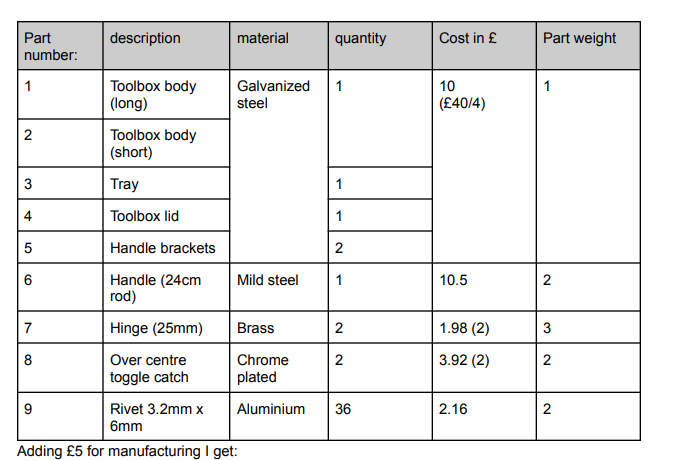

Step 2: analysis phase
The analysis phase involves determining what each aforementioned part’s function is, and it’s functional importance, and assembly importance.
Functional importance means how important that part is to the task (in this case it is holding tools)
Assembly importance means how important the part is in the assembly process (I.E. loose pieces are not important to assemble)

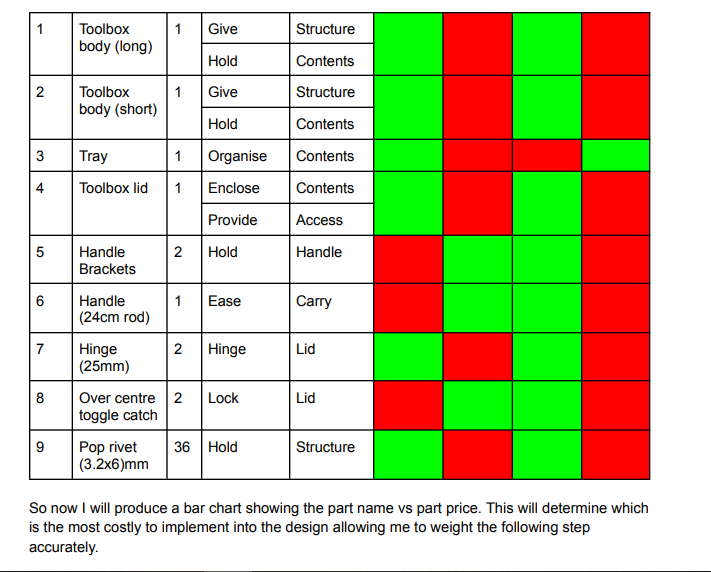
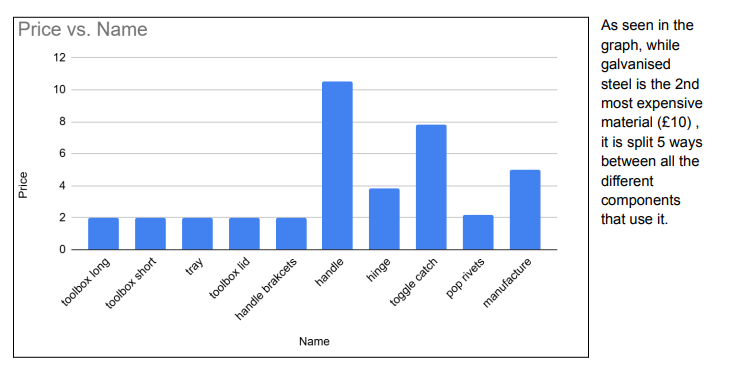
3: creative phase
The creative phase involves using creativity to come up with innovative ways to reduce costs by using the analyzed data gathered in the previous steps.
It is important to come up with as many ideas as possible when being creative, but for the sake of being concise, here are the 3 best ideas I came up with to reduce costs:
Idea 1:
Replacing the handle with 3D printed Carbon Fiber Reinforced (CFR) Nylon components. The cost analysis revealed that the handle is the single most expensive part to include in the toolbox.
While being essential to ease of transport it cannot 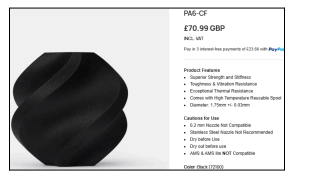
be removed so I decided to use a much cheaper
and readily available material than a 24cm steel
rod. Since I have access to BambuLab X1C which
fits the criteria to print Nylon components I decided to use this 3D printer in addition to BambuLab’s official branded PA6-CF filament (£70.99/Kg). CFR Nylon, while being weaker than metal, definitely fits
the strength requirements for the toolbox by a long way. The 3D printed handle will be the exact same shape as the previous bent metal rod, and will secure with the same handle brackets. This change will be less complex and lead to less chaos when switching manufacturing as the only difference in assembly should be the material of the product.
I predict the 3D printed handle should come to 50g of material used. With good print settings and well maintained and lubricated hardware this should be more than enough for the toolbox. Considering this, here is a comparison of the original product’s pricing compared to the revised pricing: (for the sake of conciseness I will leave out the maths involved to work out these prices)
Buy Answer of This Assessment & Raise Your Grades
| Original price | Revised price | |
| Individual handle cost | £10.50 | £3.55 |
| Cost per toolbox | £39.46 | £32.51 |
Idea 2:
Replacing the folded metal toolbox body and lid with an injection moulded ABS plastic shell
should reduce costs and improve product quality in a few ways: reducing costs by removing the
need for so much of the expensive galvanised steel sheet and removing the need for the use of
pop rivets. Improving quality by removing the sharp edges of the folded sheet metal. ABS plastic
is also recyclable which means, keeping the environment in mind, using only recycled ABS
plastic leads to a more satisfied customer on all fronts: a cheaper product, a lighter and
therefore easier to use product, and a product that’s plastic parts are recycled. I estimate that
using the injection moulding process for manufacturing the toolbox body willcost a new £5 per
unit when produced in large batches. Bringing down the cost per unit of the other sheet metal
parts as well this will lead to the following price changes occurring: (again for the same
reasons as before I will leave out the maths in calculating the revised cost)
Original price Revised price
| Original price | Revised price | |
| Sheet metal body and lid | £6.00 | £5.00 |
| Other sheet metal components | £6.00 | £2.64 |
| Pop rivets | £2.16 | £0 |
| Cost per toolbox | £39.46 | £35.10 |
These changes lead to a not much cheaper product, but definitely higher quality satisfying the
customer more than before.
Idea 3:
Combining Ideas from the previous, making the lid and body out of injection moulded ABS
plastic can get rid of the need for the hinges as well. Simply modifying theshape of the body
and the lid to intersect at an axel will function as the hinge. This could possibly lead to a better
functioning product as well, the small hinges have a chance of breaking over time due to the
amount of force being focused on small objects. Whereas if the newer integrated ABS hinge
stretches the entire length of the toolbox then the force is spread out over a larger area and
therefore will last longer than if it was focused on the two smaller areas. The slightly increased
James M Unit 4C Page 12
complexity of the design will lead to a slightly higher manufacturing cost with more complex
moulds, but this should be made up for by far with the cost savings of the hinge. I estimate the
increase in cost of the ABS body and lid will be +£0.50. And so here is a comparison of the
previous cost to the new: (again leaving out the working out for conciseness)
| Previous cost | Revised price | |
| ABS body and lid | £5.00 | £5.50 |
| Hinge | £1.98 | £0.00 |
| Cost per toolbox | £35.10 | £33 |
While being a small change in price, this change should increase the durability of the product as
well thereby increasing the user satisfaction in the long term.
4: evaluation phase
In this phase I will evaluate the effectiveness of my solutions, comparing the original and revised
costs. It is important to note that the revised costs are still educated guesses and may not
exactly represent the actual cost but nevertheless approximately will.
I will first combine the original to revised cost tables I have made for the separate improvement
methods in the previous phase.
| Original | Revised | Difference | |
| Individual handle cost | £10.50 | £3.55 | £7.05 |
| Sheet metal body and lid | £6.00 | £5.50 | £0.50 |
| Other sheet metal components | £6.00 | £3 | £3.36 |
| Pop rivets | £2.16 | £0.00 | £2.16 |
| Hinge | £1.98 | £0 | £1.98 |
| Total cost per toolbox | £39.46 | £26.01 | £13.45 |
And so here is a bar graph to better graphically represent the data. I included in the bar graph the components that did not have any change to them during the creativity stage.
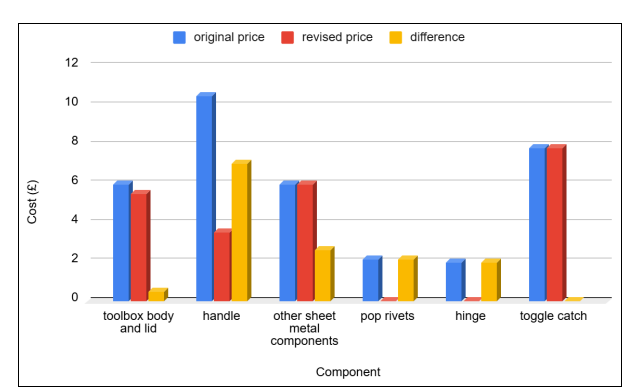
5: Development and reporting phase
Coming to the end of the value analysis, an overview will show the effectiveness of the value analysis practice I have completed.
If my recommendations for modifications to the toolbox manufacture are taken and carried out, leading to decreased costs and increased quality. Then the company should expect to see the following results:
| Savings overview | |
| Savings per unit | £13.45 |
| % savings per unit | 34.10% |
| Assumed monthly sales | £300.00 |
| Current product monthly manufacture cost | £11,838 |
| Revised product monthly manufacture cost | £7,803.00 |
| Revised product monthly savings | £4,035 |
As my table shows, putting into practice my recommendations should results in (assuming 300 sales per month) not only a monthly saving of $4,035, but an increased customer satisfaction than before as well due to the quality changes I suggested in the creativity phase.
Conclusion
After completing this report I have gained significant insight into different types of quality management systems and what their methodologies are for enforcing optimal behaviour. I covered a few standards that weren’t applicable to quality management as well. I have also learnt about the value analysis methodology through the process of carrying one out practically.
Now it is all complete I definitely feel that I have gained a better understanding of the field and could perform another value analysis on a different product if so needed. I feel that I definitely understand now how costs can be saved while maintaining product quality by the structured process of value analysis therefore reaching the end goal of maximum savings maintaining
customer satisfaction.
References
Defining a QMS and ISO 9001:
https://advisera.com/9001academy/knowledgebase/quality-management-system-what-is-it/#:~:text=A%20Quality%20Management%20System%2C%20often,they%20provide%20to%20their% 20customers.
The PDCA cycle:
https://asq.org/quality-resources/pdca-cycle
What is TQM:
https://asq.org/quality-resources/total-quality-management
ISO 9001:
https://www.iso.org/standard/62085.html
ISO 27001:
https://www.iso.org/standard/27001
ISO 14001:
https://www.iso.org/standard/60857.html
Are You Looking for Answer of This Assignment or Essay
The post BTEC engineering unit 57AB : Analysis of Quality Management Systems and Value Optimization for Competitive Advantage appeared first on Students Assignment Help UK.